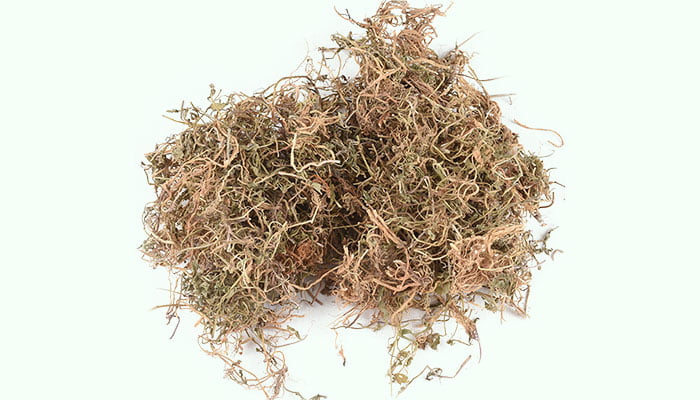What Is Lobelia Chinensis
Lobelia Chinensis is commonly known as Chinese Lobelia or Ban Bian Lian, which is a small perennial herb belonging to the family Campanulaceae. It is a relatively practical and common Chinese herbal medicine, which first appeared in <Compendium of Materia Medica> in 1,578 AD.
This plant is hardy and likes humid environments. It often grows in fields, grasslands, and riversides at an altitude of 500-1,600 meters, and has now been artificially planted. It can be found in China, Japan, Korea, Vietnam, Laos, Thailand, Cambodia, Nepal, India, and Malaysia.
Generally, most plants of this genus contain lobeline. lobeline was often used as a smoking cessation aid in the early stages.
Because of the lack of efficacy data to determine its safety and effectiveness, since 1993, the FDA has banned lobeline as a smoking cessation aid [1].
Nevertheless, some studies indicate that lobeline may be beneficial in the treatment of alcohol addiction [2], methamphetamine addiction [3], and heroin addiction [4].

In the summer of each year, people gather Lobelia chinensis, remove their impurities, wash them with water, use them directly, or cut them into sections, dry them in the sun, and make them into Chinese herbal medicines.
Lobelia Chinensis contains apigenin, luteolin, diosmetin, chrysoeriol, hesperidin, linarin, diosmin, norlobelanine, lobeline, lobelanidine, Lobelanine, lobechine, cycloeucalenol, 24-methylenecycloartanol, phytol, palmitic acid, isoferulic acid, stearic acid, fumaric acid, succinic acid, p-hydroxybenzoic acid, β-sitosterol, daucosterol, β-amyrin, adenosine, coumarins, amino acids, glucose, and fructose.
According to <Compendium of Materia Medica>, the medicinal nature of Lobelia Chinensis is relatively neutral, with slight toxicity and pungent taste. It has a certain therapeutic effect on the pathological changes of the heart, lung, and small intestine meridians.
In traditional Chinese medicine, Lobelia Chinensis is often used to clear heat and remove toxins, induce diuresis and reduce edema, treat herpes zoster, eczema, dysentery, jaundice, acute mastitis, acute glomerulonephritis, acute cellulitis, acute bronchitis, bronchopneumonia, acute respiratory infection, whooping cough, advanced schistosomiasis, and snakebite.
Benefits
- Anti-inflammation, anti-virus, and anti-oxidation.
- Promoting bile secretion, having analgesic, and anti-myocardial ischemia-reperfusion effects.
- Inhibiting the activity of α-glucosidase and lowering blood sugar.
- Enhancing capillary tension, reducing the capillary permeability, and improving microcirculation.
- Stimulating N1 receptors of the carotid sinus and aortic body chemoreceptors to exciting the respiratory center.
- Inhibiting endothelin gene transcription, protein synthesis and translation, preventing and treating vascular diseases caused by renal hypertension.
- Inhibiting the proliferation of Hela cells, ovarian cancer cells HO-8910PM, HepG2 cells, and myeloma cells U266.
- Promoting urination and increasing the excretion of chloride in the urine.
- Treating dysuria, and jaundice caused by damp-heat.
- Treating extensive abdominal edema caused by the retention of water-dampness.
- Removing heat toxins, treating sores and carbuncles caused by heat toxins.
- Relieving swelling and pain of acute mastitis, bee and scorpion stings, and snake bites.
- Inhibiting Staphylococcus aureus, typhoid bacilli, paratyphoid bacilli, Shigella flexneri, Escherichia coli, Proteus, and Pseudomonas aeruginosa.
- The topical application after mashing it can treat skin eczema.
- Studies have confirmed that intramuscular injection of lobeline can induce vomiting. But it is unsafe and should not be used as an emetic.
Combinations
- It can be used in combination with E Bu Shi Cao (Centipeda Minima), etc. to treat whooping cough.
- It can be used in combination with Bai Mao Cen (Rhizoma Imperatae), etc. to treat dysuria, and jaundice caused by damp-heat.
- It can be used in combination with Bai Hua She She Cao (Hedyotis Diffusa), Hu Zhang (Polygoni Cuspidati Rhizoma et Radix), Qian Cao (Radix Rubiae), etc. to treat bee and scorpion stings, and snake bites.
- It can be used in combination with Jin Qian Cao (Lysimachia), Da Huang (Radix et Rhizoma Rhei), and Zhi Shi (Fructus Aurantii Immaturus), etc. to treat extensive abdominal edema caused by the retention of water-dampness.
- It can be used in combination with Jin Yin Hua (Flos Lonicerae), Hong Zao (Fructus Jujubae), and Ge Gen (Kudzu Root), etc. to treat infantile eczema.
Side Effects
- Lobelia Chinensis is considered to be mildly toxic.
- A small proportion of patients taking it may cause dizziness, headache, sweating, salivation, nausea, vomiting, diarrhea, or increased heart rate.
- In severe cases, it may cause muscle twitching, difficulty breathing, coma, dilated pupils, decreased blood pressure, and even respiratory central paralysis leading to death.
Precautions and Warnings
- The dosage of Lobelia Chinensis should be controlled at 10-15g.
- When using fresh Lobelia Chinensis, the dosage should be controlled at 30-60g.
- It can be made into decoctions, injections, or mashed for external use.
- People who are allergic to Lobelia Chinensis should not take it.
- It should not be used to treat edema caused by deficiency syndromes.
- Patients with deficiency-cold in the spleen and stomach should not take it.
- Children, pregnant women, and lactating women should not take it.
Treatment for poisoning
If the patient takes it and causes adverse reactions, please seek medical attention in time.
The following treatment methods for poisoning are for reference only, please refer to the doctor’s diagnosis.
- It is recommended to induce vomiting and gastric lavage in the early stage of poisoning.
- It is recommended to inject phenobarbital intramuscularly or slowly intravenously sodium pentobarbital.
- When taking it to cause breathing difficulties, it is recommended to use central stimulants and artificial respiration.
- When taking it to cause heart failure, it is recommended to use Lanatoside C or Strophanthin K.
